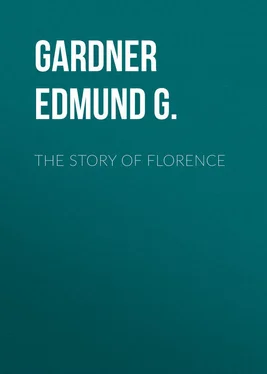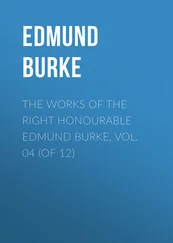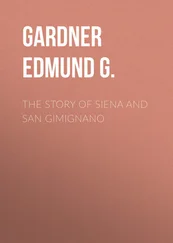Edmund Gardner - The Story of Florence
Здесь есть возможность читать онлайн «Edmund Gardner - The Story of Florence» — ознакомительный отрывок электронной книги совершенно бесплатно, а после прочтения отрывка купить полную версию. В некоторых случаях можно слушать аудио, скачать через торрент в формате fb2 и присутствует краткое содержание. Жанр: История, foreign_antique, foreign_prose, на английском языке. Описание произведения, (предисловие) а так же отзывы посетителей доступны на портале библиотеки ЛибКат.
- Название:The Story of Florence
- Автор:
- Жанр:
- Год:неизвестен
- ISBN:нет данных
- Рейтинг книги:3 / 5. Голосов: 1
-
Избранное:Добавить в избранное
- Отзывы:
-
Ваша оценка:
- 60
- 1
- 2
- 3
- 4
- 5
The Story of Florence: краткое содержание, описание и аннотация
Предлагаем к чтению аннотацию, описание, краткое содержание или предисловие (зависит от того, что написал сам автор книги «The Story of Florence»). Если вы не нашли необходимую информацию о книге — напишите в комментариях, мы постараемся отыскать её.
The Story of Florence — читать онлайн ознакомительный отрывок
Ниже представлен текст книги, разбитый по страницам. Система сохранения места последней прочитанной страницы, позволяет с удобством читать онлайн бесплатно книгу «The Story of Florence», без необходимости каждый раз заново искать на чём Вы остановились. Поставьте закладку, и сможете в любой момент перейти на страницу, на которой закончили чтение.
Интервал:
Закладка:
When the news reached Florence, the Ghibellines trembled for their safety, and the people prepared to win back their own. An attempt at compromise was first made, under the auspices of Pope Clement. Two Frati Gaudenti or "Cavalieri di Maria," members of an order of warrior monks from Bologna, were made Podestàs, one a Guelf and one a Ghibelline, to come to terms with the burghers. You may still trace the place where the Bottega and court of the Calimala stood in Mercato Nuovo (the Calimala being the Guild of dressers of foreign cloth–panni franceschi, as Villani calls it), near where the Via Porta Rossa now enters the present Via Calzaioli. Here the new council of thirty-six of the best citizens, burghers and artizans, with a few trusted members of the nobility, met every day to settle the affairs of the State. Dante has branded these two warrior monks as hypocrites, but, as Capponi says, from this Bottega issued at once and almost spontaneously the Republic of Florence. Their great achievement was the thorough organisation of the seven greater Guilds, of which more presently, to each of which were given consuls and rectors, and a gonfalon or ensign of its own, around which its followers might assemble in arms in defence of People and Commune. To counteract this, Guido Novello brought in more troops from the Ghibelline cities of Tuscany, and increased the taxes to pay his Germans; until he had fifteen hundred horsemen in the city under his command. With their aid the nobles, headed by the Lamberti, rushed to arms. The people rose en masse and, headed by a Ghibelline noble, Gianni dei Soldanieri, who apparently had deserted his party in order to get control of the State (and who is placed by Dante in the Hell of traitors), raised barricades in the Piazza di Santa Trinità and in the Borgo SS. Apostoli, at the foot of the Tower of the Girolami, which still stands. The Ghibellines and Germans gathered in the Piazza di San Giovanni, held all the north-east of the town, and swept down upon the people's barricades under a heavy fire of darts and stones from towers and windows. But the street fighting put the horsemen at a hopeless disadvantage, and, repulsed in the assault, the Count and his followers evacuated the town. This was on St Martin's day, November 11th, 1266. The next day a half-hearted attempt to re-enter the city at the gate near the Ponte alla Carraia was made, but easily driven off; and for two centuries and more no foreigner set foot as conqueror in Florence.
Not that Florence either obtained or desired absolute independence. The first step was to choose Charles of Anjou, the new King of Naples and Sicily, for their suzerain for ten years; but, cruel tyrant as he was elsewhere, he showed himself a true friend to the Florentines, and his suzerainty seldom weighed upon them oppressively. The Uberti and others were expelled, and some, who held out among the castles, were put to death at his orders. But the government became truly democratic. There was a central administration of twelve Ancients, elected annually, two for each sesto; with a council of one hundred "good men of the People, without whose deliberation no great thing or expense could be done"; and, nominally at least, a parliament. Next came the Captain of the People (usually an alien noble of democratic sympathies), with a special council or credenza , called the Council of the Captain and Capetudini (the Capetudini composed of the consuls of the Guilds), of 80 members; and a general council of 300 (including the 80), all popolani and Guelfs. Next came the Podestà, always an alien noble (appointed at first by King Charles), with the Council of the Podestà of 90 members, and the general Council of the Commune of 300–in both of which nobles could sit as well as popolani. Measures presented by the 12 to the 100 were then submitted successively to the two councils of the Captain, and then, on the next day, to the councils of the Podestà and the Commune. Occasionally measures were concerted between the magistrates and a specially summoned council of richiesti , without the formalities and delays of these various councils. Each of the seven greater Arts 7 7 The Arte di Calimala, or of the Mercatanti di Calimala, the dressers of foreign cloth; the Arte della Lana, or wool; the Arte dei Giudici e Notai, judges and notaries, also called the Arte del Proconsolo; the Arte del Cambio or dei Cambiatori, money-changers; the Arte dei Medici e Speziali, physicians and apothecaries; the Arte della Seta, or silk, also called the Arte di Por Santa Maria; and the Arte dei Vaiai e Pellicciai, the furriers. The Minor Arts were organised later.
was further organised with its own officers and councils and banners, like a miniature republic, and its consuls (forming the Capetudini) always sat in the Captain's council and usually in that of the Podestà likewise.
There was one dark spot. A new organisation was set on foot, under the auspices of Pope Clement and King Charles, known as the Parte Guelfa–another miniature republic within the republic–with six captains (three nobles and three popolani) and two councils, mainly to persecute the Ghibellines, to manage confiscated goods, and uphold Guelf principles in the State. In later days these Captains of the Guelf Party became exceedingly powerful and oppressive, and were the cause of much dissension. They met at first in the Church of S. Maria sopra la Porta (now the Church of S. Biagio), and later had a special palace of their own–which still stands, partly in the Via delle Terme, as you pass up it from the Via Por Santa Maria on the right, and partly in the Piazza di San Biagio. It is an imposing and somewhat threatening mass, partly of the fourteenth and partly of the early fifteenth century. The church, which retains in part its structure of the thirteenth century, had been a place of secret meeting for the Guelfs during Guido Novello's rule; it still stands, but converted into a barracks for the firemen of Florence.
Thus was the greatest and most triumphant Republic of the Middle Ages organised–the constitution under which the most glorious culture and art of the modern world was to flourish. The great Guilds were henceforth a power in the State, and the Secondo Popolo had arisen–the democracy that Dante and Boccaccio were to know.
CHAPTER II
The Times of Dante and Boccaccio
"Godi, Fiorenza, poi che sei sì grande
che per mare e per terra batti l'ali,
e per l'inferno il tuo nome si spande."
THE century that passed from the birth of Dante in 1265 to the deaths of Petrarch and Boccaccio, in 1374 and 1375 respectively, may be styled the Trecento , although it includes the last quarter of the thirteenth century and excludes the closing years of the fourteenth. In general Italian history, it runs from the downfall of the German Imperial power at the battle of Benevento, in 1266, to the return of the Popes from Avignon in 1377. In art, it is the epoch of the completion of Italian Gothic in architecture, of the followers and successors of Niccolò and Giovanni Pisano in sculpture, of the school of Giotto in painting. In letters, it is the great period of pure Tuscan prose and verse. Dante and Giovanni Villani, Dino Compagni, Petrarch, Boccaccio and Sacchetti, paint the age for us in all its aspects; and a note of mysticism is heard at the close (though not from a Florentine) in the Epistles of St. Catherine of Siena, of whom a living Italian poet has written– Nel Giardino del conoscimento di sè ella è come una rosa di fuoco. But at the same time it is a century full of civil war and sanguinary factions, in which every Italian city was divided against itself; and nowhere were these divisions more notable or more bitterly fought out than in Florence. Yet, in spite of it all, the Republic proceeded majestically on its triumphant course. Machiavelli lays much stress upon this in the Proem to his Istorie Fiorentine . "In Florence," he says, "at first the nobles were divided against each other, then the people against the nobles, and lastly the people against the populace; and it ofttimes happened that when one of these parties got the upper hand, it split into two. And from these divisions there resulted so many deaths, so many banishments, so many destructions of families, as never befell in any other city of which we have record. Verily, in my opinion, nothing manifests more clearly the power of our city than the result of these divisions, which would have been able to destroy every great and most potent city. Nevertheless ours seemed thereby to grow ever greater; such was the virtue of those citizens, and the power of their genius and disposition to make themselves and their country great, that those who remained free from these evils could exalt her with their virtue more than the malignity of those accidents, which had diminished them, had been able to cast her down. And without doubt, if only Florence, after her liberation from the Empire, had had the felicity of adopting a form of government which would have kept her united, I know not what republic, whether modern or ancient, would have surpassed her–with such great virtue in war and in peace would she have been filled."
Читать дальшеИнтервал:
Закладка:
Похожие книги на «The Story of Florence»
Представляем Вашему вниманию похожие книги на «The Story of Florence» списком для выбора. Мы отобрали схожую по названию и смыслу литературу в надежде предоставить читателям больше вариантов отыскать новые, интересные, ещё непрочитанные произведения.
Обсуждение, отзывы о книге «The Story of Florence» и просто собственные мнения читателей. Оставьте ваши комментарии, напишите, что Вы думаете о произведении, его смысле или главных героях. Укажите что конкретно понравилось, а что нет, и почему Вы так считаете.












